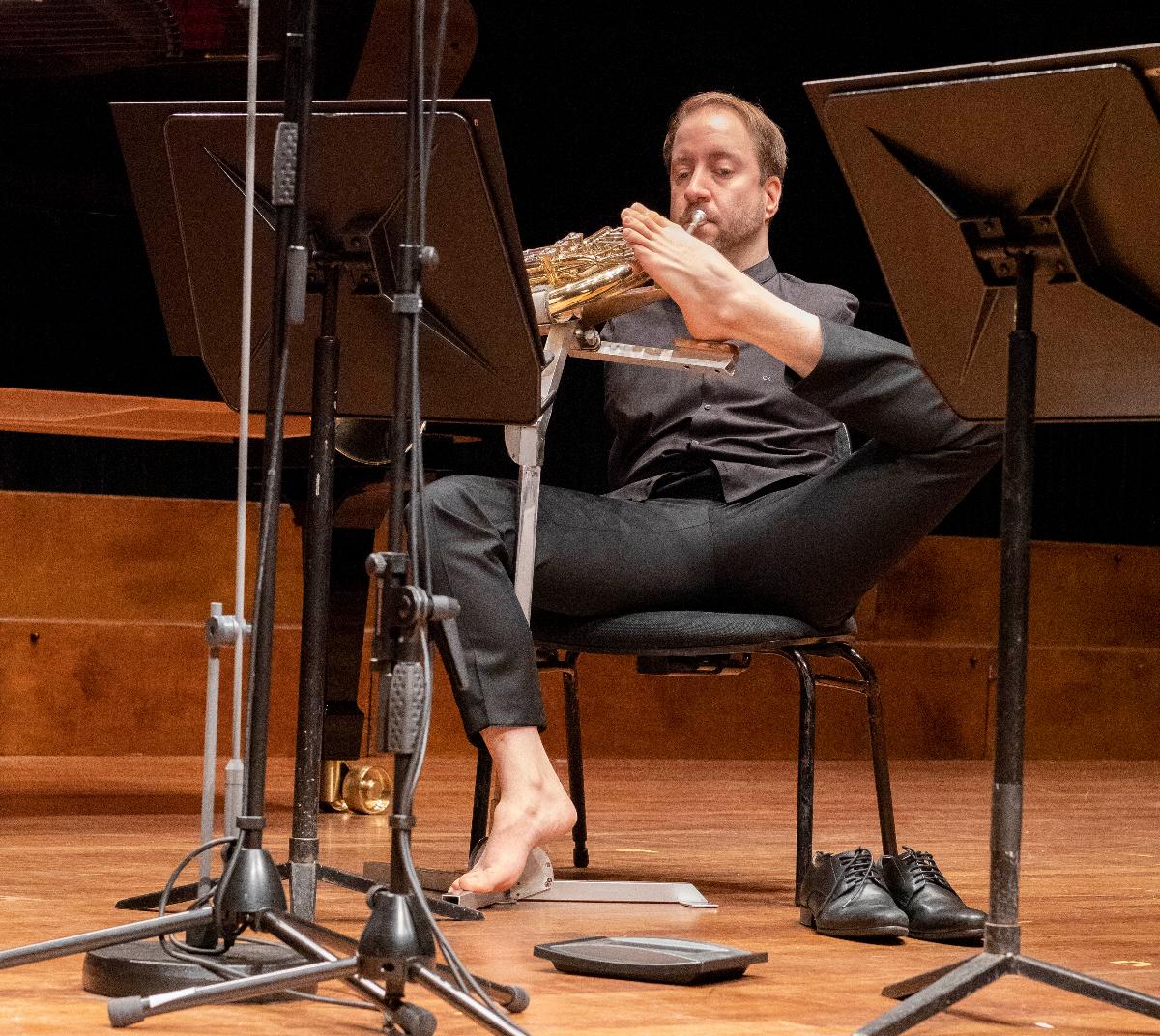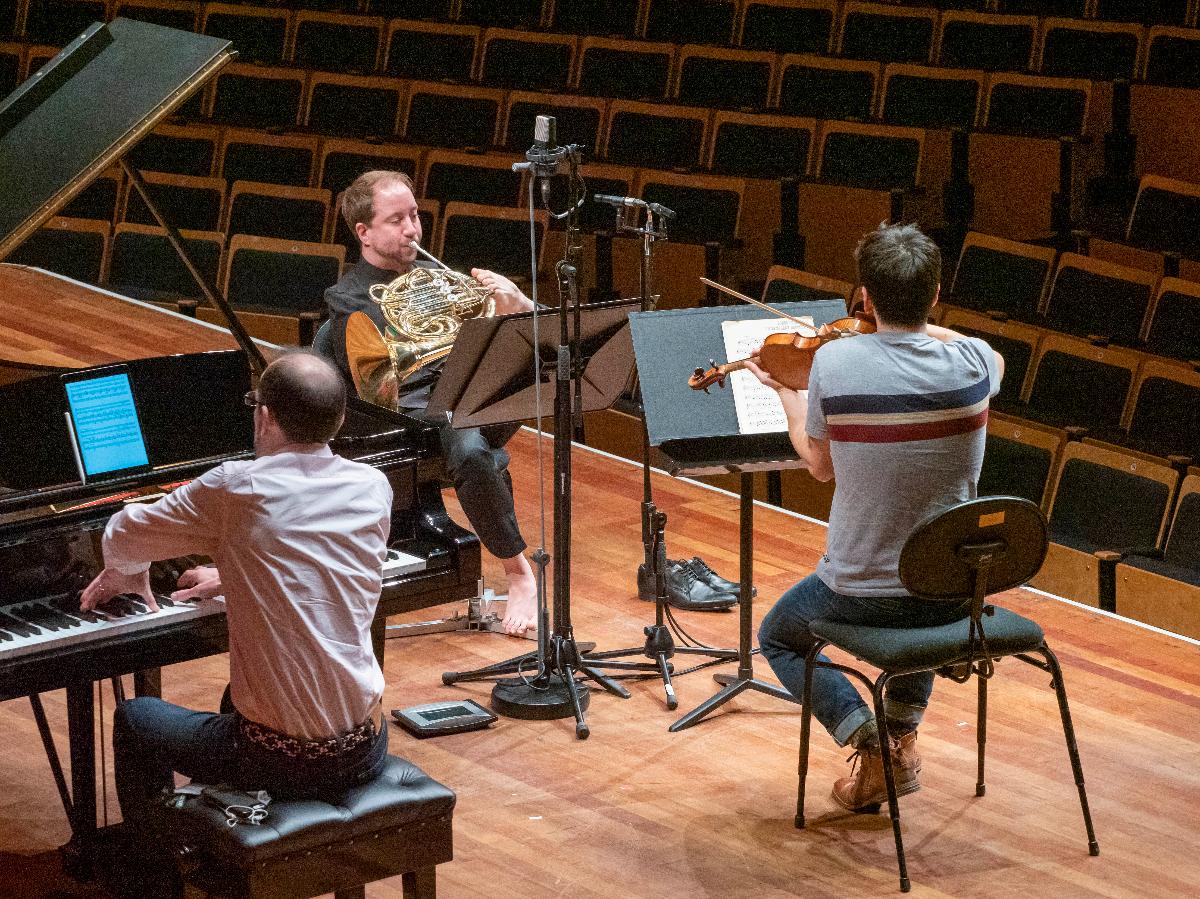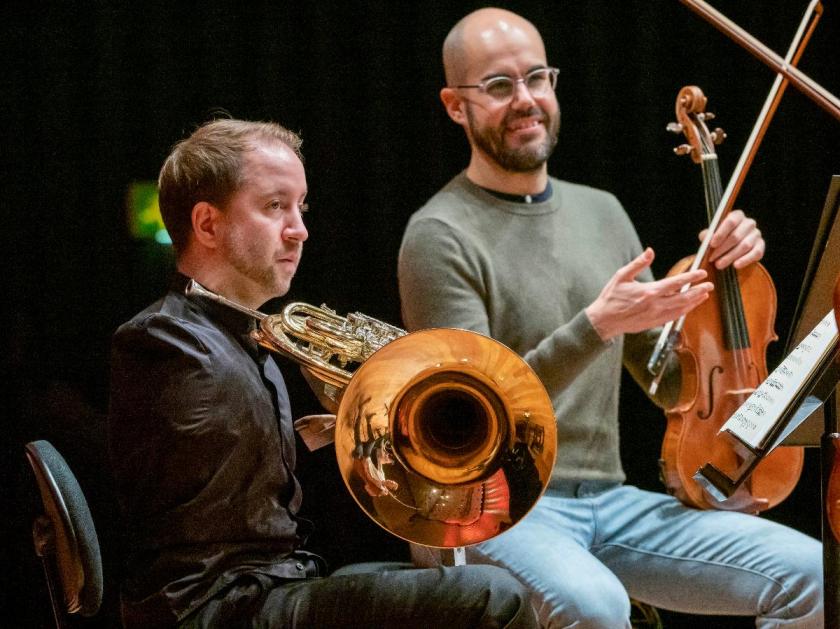Although the large auditorium of Lighthouse, Poole may not offer the most favourable scale and intimacy for a chamber recital, the high quality of communicative chemistry and performance readily reached out to engage and hold the audience spellbound for the whole evening.
For those still unaware, Felix Klieser has been making much news in recent times. Appointed last year as the BSO’s new Artist-in-Residence, he has already impressed in a performance of Mozart’s Horn Concerto No.4 with the orchestra conducted by Kirill Karabits. As well as concerto performances and chamber recitals, his two-year residency will enable him to get to know the players and administration as well as work with the BSO Participate and BSO Resound initiatives.
Felix (pictured below) is a professional horn player from Germany, who started lessons when just five years of age. He had such an innate affinity with his chosen instrument that, although born without arms, he has been able to develop a method of operating the valves with his left foot while the horn is held in place on a tripod. With the development of an amazingly adaptable range of embouchure in tandem with an alternative to hand stopping and seemingly limitless breath control, his flexibility of technique matched with characteristic brass sound seemingly knows no bounds - admirably demonstrated in this concert’s celebration of all things E flat.  What a gift to open with a work that Mozart himself openly proclaimed and rightly knew to be one of his very best, the Quintet for piano and winds K.452. Klieser was joined by oboist Edward Kay, clarinettist Barry Deacon and bassoonist Tammy Thorn, with Danny Driver the lynchpin at the piano. Innovative for its time, the combination inspired the composer to highlight the individual timbres and character of each instrument, at the same time allowing their variously combined colours to compliment phrasing and mood. Responding generously to Mozart’s evenly distributed mix, the performance felt imbued with the breath of life itself, relishing shared give-and-take and individual moments in the sun that gleamed with the brilliance of a multi-faceted diamond.
What a gift to open with a work that Mozart himself openly proclaimed and rightly knew to be one of his very best, the Quintet for piano and winds K.452. Klieser was joined by oboist Edward Kay, clarinettist Barry Deacon and bassoonist Tammy Thorn, with Danny Driver the lynchpin at the piano. Innovative for its time, the combination inspired the composer to highlight the individual timbres and character of each instrument, at the same time allowing their variously combined colours to compliment phrasing and mood. Responding generously to Mozart’s evenly distributed mix, the performance felt imbued with the breath of life itself, relishing shared give-and-take and individual moments in the sun that gleamed with the brilliance of a multi-faceted diamond.
The change from wind to string accompaniment without piano in the Horn Quintet, K407 moved the horn more into the spotlight. Klieser was partnered by Mark Derudder, violin, unusually two violas - Tom Beer and Miguel Rodriguez, with Jesper Svedberg, cello. The violas made for a distinctively mellow alto register, throwing into relief the operatic interplay of the lyrical writing for horn and violin underpinned by the cello. Mozart’s contrast of joyful and tender music was beautifully drawn between the central Andante’s aria framed by the sprightly energy of the outer movements. The finale’s sparkling quick-fire repartee between solo horn and the rest of the ensemble was breathtakingly virtuosic as if inviting lyrics for a Flanders and Swann patter song.
After the interval the Brahms Horn Trio (Klieser with Danny Driver and Mark Derudder pictured below) rehearsal pictured below) took us deep into the forest. Despite being composed with the almost obsolete valveless horn in mind, Brahms’ horn writing is very much the stylistic pivot between Mozart and Richard Strauss in its natural facility and appreciation of the instrument’s potential learned from his father, who was also a professional player. The first movement was lyrically expressive without indulgence before the players are let off the leash by the rhythmic exuberance of the Scherzo, pausing for breath for the central Trio’s glorious horn melody. The third movement takes the work to an almost symphonic level of intensity. The composer’s mother had died shortly before, and the tone here was appropriately elegiac and grief-stricken. All change for the finale, in which all three soloists joust to see who will win the hunt. Vaulting interplay between the three protagonists made for a thrilling ride to close an irresistibly robust and darkly passionate performance.  The proceedings didn’t end here however. With barely time for anyone to catch breath or take stock, an encore followed perhaps somewhat too swiftly. This turned out to be a repeat of the closing reprise of the Brahms Scherzo. Might a change of mood to a short piece such as Gilbert Vinter’s Hunter’s Moon have been more appropriate? Without wishing to appear ungrateful, after such satisfying and inspirational performances neither option was really necessary. Sometimes less really is more.
The proceedings didn’t end here however. With barely time for anyone to catch breath or take stock, an encore followed perhaps somewhat too swiftly. This turned out to be a repeat of the closing reprise of the Brahms Scherzo. Might a change of mood to a short piece such as Gilbert Vinter’s Hunter’s Moon have been more appropriate? Without wishing to appear ungrateful, after such satisfying and inspirational performances neither option was really necessary. Sometimes less really is more.
So to end on a positive note, the interactive listening and intuitive ensemble of the principals from the main orchestra consistently lent significant added resonance and cohesion to each work in the programme. Danny Driver’s realisation of the challenging piano part matched with Mark Derudder’s soaring and searing sense of line in the Brahms, together with the lustrous horn playing and extraordinary musical achievement of Felix Klieser throughout were still ringing in sound and vision this morning.
Excerpts from the chamber recital on YouTube














Add comment